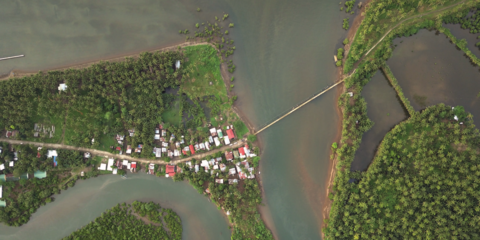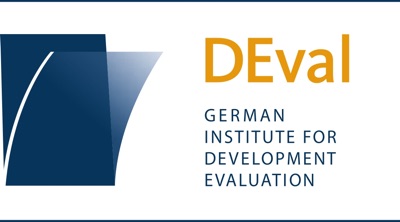
Environment and Rural Development in the Philippines
German development cooperation supported the Philippine authorities in land-use planning over a ten-year period. The evaluation used rigorous methods to examine whether the planned positive impacts on the sustainable use of natural resources, local governance and disaster risk management did indeed occur.
Like many other developing and emerging countries, the Philippines face a multitude of environmental and economic challenges: The high risk of environmental and natural disasters is further amplified by the consequences of climate change; high population growth and uneven economic development result in heavy pressure on the use of scarce natural resources. Against this backdrop, the sustainable use of land is of crucial importance.
The instrument of land-use planning makes it possible to ensure equitable and transparent distribution of the resource of land and to manage its sustainable use. It also enables potential conflicts over use to be identified and mitigated.
Between 2006 and 2015, German development cooperation facilitated the implementation of a package of measures under the “Environment and Rural Development” programme in order to improve land-use planning in the Philippines. The aim was to boost the partners’ competences in this area on a lasting basis and, at the same time, to ensure better protection of natural resources and better disaster risk management. A further aim was to improve the living conditions of rural households.
Results and Recommendations
- Land-use planning is a central element when it comes to supporting rural development in partner countries.
-
However, existing conflicts over land and land use as well as the economic and political power structures in the country need to be considered at an early stage in programme and project conception. This is the only way to make sure that all actors have a sense of commitment to goals which serve the common good. To strengthen the position of marginalised groups, it is important to systematically involve civil society in the processes of land-use planning.
- The number of designated nature conservation areas was increased, as were capacities in the field of disaster risk management; no measurable improvements were observed in the living conditions of rural households.
-
In order to make better use of potential synergy effects between land-use planning measures and other rural development interventions, systematic coordination and integration with other interventions by German, local and international actors is recommended.
- Land-use planning issues are spread across different authorities in the Philippines, which results in overlapping mandates and high coordination costs.
-
Although the cooperation between authorities has been improved, comprehensive land-use planning still poses challenges. Political structures and framework conditions should be put in place which make it possible to implement and enforce the planned goals with legal certainty at the local level and to underpin data-sharing between authorities.
The evaluation was completed in 2018. This is a summary of the results and recommendations; you can find the complete results and recommendations in the report.
Objectives of the Evaluation
The impact evaluation aimed to obtain reliable findings on the implementation and the impacts of ten years of comprehensive land-use planning at the level of households, barangays (administrative units referring to village, ward or neighbourhood) and municipalities.
To this end, the evaluation used rigorous methods to examine the technical approach implemented in the Philippines for comprehensive and participatory land-use planning and capacity development. This approach ranged from the municipal to the national level, and supported decentralised planning, sustainable use of natural resources, and resilience in the face of natural risks and climate change. The chosen methodology permitted the evaluation to measure the combined impacts of “SIMPLE” (Sustainable Integrated Management and Planning for Local Government Ecosystems) – the approach to land-use planning implemented by the Philippine-German cooperation – along with the resulting Comprehensive Land Use Plan Guidebook (2013–14) issued by the Housing and Land Use Regulatory Board (HLURB) of the Philippine government.
The evaluation objectives followed the OECD-DAC evaluation criteria:
- Relevance: examining the extent to which the comprehensive land-use planning approach is consistent with the current development plans; this also includes its contribution to the Sustainable Development Goals (SDGs) and hence the current global development agenda.
- Effectiveness: establishing whether and under what conditions the approach to comprehensive land-use planning has improved land-use planning in reality.
- Impact: establishing whether and under what conditions the approach to comprehensive land-use planning is making a difference in the relevant fields of development.
- Sustainability: assessing whether the benefits of the intervention are lasting, particularly with regard to innovation diffusion and the scaling up of the approach.
These evaluation objectives gave rise to the following evaluation questions:
- To what extent and in what ways did the intervention improve land-use planning practices and techniques?
- To what extent and in what ways has enhanced land-use planning led to
a) actual change in land use and more sustainable natural resource management?
b) improved disaster risk management?
c) improved local governance?
d) improved welfare?
The evaluation also answered questions on cross-cutting issues:
- What are relevant findings with regard to the sustainability of the intervention and the continuity of intervention benefits, particularly with regard to innovation diffusion, scaling-up and replication of land-use planning processes?
- To what extent is enhanced land-use planning consistent with development agendas, and in what ways does enhanced land-use planning contribute to the SDGs?
Background
The technical approach named “SIMPLE” (Sustainable Integrated Management and Planning for Local Government Ecosystems) was developed within the Environment and Rural Development (EnRD) programme under the joint responsibility of the Deutsche Gesellschaft für Internationale Zusammenarbeit (GIZ) and the Philippine partners. The approach aimed to bring about improvements in land-use planning and disaster risk management. Reasons for this intervention were that the former fragmented system for the planning and management of land and water bodies had left many communities with outdated, inconsistent and incomplete land-use plans. The necessity of improving land use and land-use planning was heightened by ever-increasing land scarcity, land degradation and natural and environmental risks in the Philippines.
The SIMPLE approach emphasises a comprehensive and participatory form of land-use planning which seeks to engage all stakeholders in the process and organises land-use planning from the bottom up, from barangay to municipal level. The SIMPLE approach also integrates land-use planning across all ecosystems, from mountain peaks to the ocean.
The EnRD programme was officially ended in 2015. The Housing and Land Use Regulatory Board (HLURB) of the Philippines government is the lead authority supporting local governments in the preparation of comprehensive land-use plans, and maintained intensive cooperation with the EnRD programme for many years. The approach of participatory land-use planning coupled with integrated ecosystem management, which also follows participatory approaches, was implemented and scaled up at the national level under the HLURB's National Guidelines for the preparation of Comprehensive Land Use Plans (2013–14); the guidelines officially came into force in November 2015.
Methods
The evaluation followed a theory-based approach and was based on rigorous measurement of impact within a mixed-methods design. Panel data from a quantitative multi-level survey at household, barangay and municipal level was linked with qualitative interviews and focus group discussions as well as geographical data. This was supplemented with a review of literature and a document analysis of land-use plans. The initial methodological design is based on a preliminary study on the first cycle of data collection, published by Garcia Schustereder et al. in 2016.
The panel datasets comprised data from 3,000 households, 300 barangays and 100 municipalities, some of which received GIZ support under the SIMPLE approach. These datasets cover eleven provinces in the Visayas regions and were collected at two points in time (2012 and 2016). The method of impact assessment is based on a quasi-experimental design using propensity score matching with a time-lagged dependent variable. This procedure made it possible to identify ‘statistical twins’ based on various statistical characteristics of the municipalities, barangays and households.
As a consequence, the impacts could be attributed to the complex intervention on land-use planning and the impacts of the intervention measured and evaluated with methodological rigour. The analysis considered effects on a large number of indicators at household, barangay and municipal level in five targeted fields of development.
Team
- Dr Gerald Leppert Former Senior Evaluator - Team Leader DEval
- Dr Lena Hohfeld Former Evaluator DEval
- Dr Malte Lech Former Evaluator, DEval
- Dr Thomas Wencker Senior Evaluator - Team Leader
- Dr Melody Garcia Schustereder Former Consultant DEval
Contact
Dr Sven Harten
Phone: +49 (0)228 336907-950
E-mail: sven.harten@DEval.org
Related Documents and Links
Publications
- A Proof-of-Concept of Integrating Machine Learning, Remote Sensing, and Survey Data in Evaluations. The Measurement of Disaster Resilience in the Philippines
- Evaluating Resilience-Centered Development Interventions with Remote Sensing
- Policy Brief: Impacts for Rural Development Land-Use Planning in the Philippines
- Policy Brief: Wirkungen in der ländlichen Entwicklung - Landnutzungsplanung auf den Philippinen
- Impact, Diffusion and Scaling-Up of a Comprehensive Land-Use Planning Approach in the Philippines: From Development Cooperation to National Policies
- Policy Brief: Current Issues of the Philippine Land Use Planning and Management System
- Donor-assisted land-use planning in the Philippines: insights from a multi-level survey

